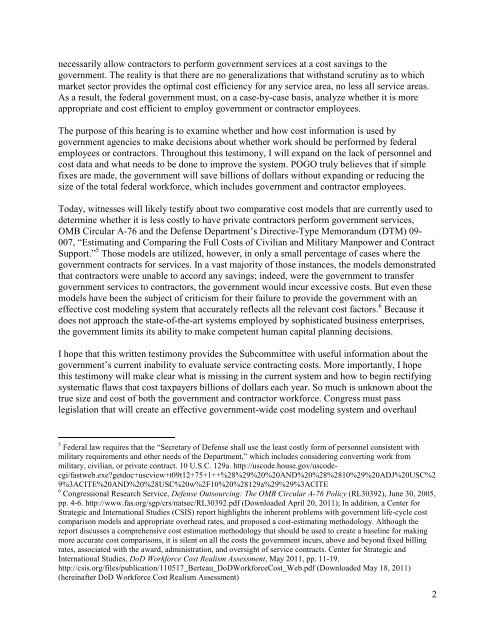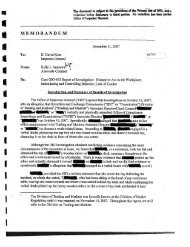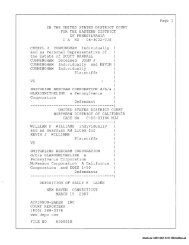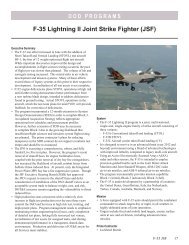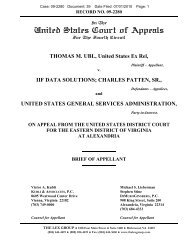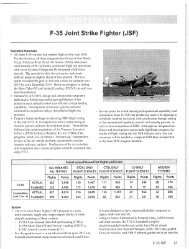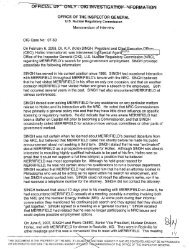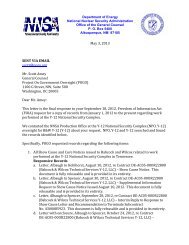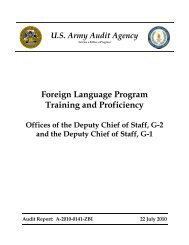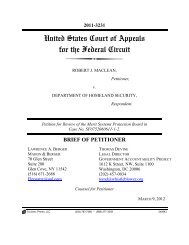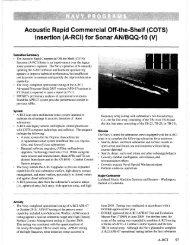SA McCaskill Cost Hearing Final 03 29 12 - U.S. Senate Homeland ...
SA McCaskill Cost Hearing Final 03 29 12 - U.S. Senate Homeland ...
SA McCaskill Cost Hearing Final 03 29 12 - U.S. Senate Homeland ...
Create successful ePaper yourself
Turn your PDF publications into a flip-book with our unique Google optimized e-Paper software.
necessarily allow contractors to perform government services at a cost savings to the<br />
government. The reality is that there are no generalizations that withstand scrutiny as to which<br />
market sector provides the optimal cost efficiency for any service area, no less all service areas.<br />
As a result, the federal government must, on a case-by-case basis, analyze whether it is more<br />
appropriate and cost efficient to employ government or contractor employees.<br />
The purpose of this hearing is to examine whether and how cost information is used by<br />
government agencies to make decisions about whether work should be performed by federal<br />
employees or contractors. Throughout this testimony, I will expand on the lack of personnel and<br />
cost data and what needs to be done to improve the system. POGO truly believes that if simple<br />
fixes are made, the government will save billions of dollars without expanding or reducing the<br />
size of the total federal workforce, which includes government and contractor employees.<br />
Today, witnesses will likely testify about two comparative cost models that are currently used to<br />
determine whether it is less costly to have private contractors perform government services,<br />
OMB Circular A-76 and the Defense Department’s Directive-Type Memorandum (DTM) 09-<br />
007, “Estimating and Comparing the Full <strong>Cost</strong>s of Civilian and Military Manpower and Contract<br />
Support.” 5 Those models are utilized, however, in only a small percentage of cases where the<br />
government contracts for services. In a vast majority of those instances, the models demonstrated<br />
that contractors were unable to accord any savings; indeed, were the government to transfer<br />
government services to contractors, the government would incur excessive costs. But even these<br />
models have been the subject of criticism for their failure to provide the government with an<br />
effective cost modeling system that accurately reflects all the relevant cost factors. 6 Because it<br />
does not approach the state-of-the-art systems employed by sophisticated business enterprises,<br />
the government limits its ability to make competent human capital planning decisions.<br />
I hope that this written testimony provides the Subcommittee with useful information about the<br />
government’s current inability to evaluate service contracting costs. More importantly, I hope<br />
this testimony will make clear what is missing in the current system and how to begin rectifying<br />
systematic flaws that cost taxpayers billions of dollars each year. So much is unknown about the<br />
true size and cost of both the government and contractor workforce. Congress must pass<br />
legislation that will create an effective government-wide cost modeling system and overhaul<br />
5 Federal law requires that the “Secretary of Defense shall use the least costly form of personnel consistent with<br />
military requirements and other needs of the Department,” which includes considering converting work from<br />
military, civilian, or private contract. 10 U.S.C. 1<strong>29</strong>a. http://uscode.house.gov/uscodecgi/fastweb.exe?getdoc+uscview+t09t<strong>12</strong>+75+1++%28%<strong>29</strong>%20%20AND%20%28%2810%<strong>29</strong>%20ADJ%20USC%2<br />
9%3ACITE%20AND%20%28USC%20w%2F10%20%281<strong>29</strong>a%<strong>29</strong>%<strong>29</strong>%3ACITE<br />
6 Congressional Research Service, Defense Outsourcing: The OMB Circular A-76 Policy (RL3<strong>03</strong>92), June 30, 2005,<br />
pp. 4-6. http://www.fas.org/sgp/crs/natsec/RL3<strong>03</strong>92.pdf (Downloaded April 20, 2011); In addition, a Center for<br />
Strategic and International Studies (CSIS) report highlights the inherent problems with government life-cycle cost<br />
comparison models and appropriate overhead rates, and proposed a cost-estimating methodology. Although the<br />
report discusses a comprehensive cost estimation methodology that should be used to create a baseline for making<br />
more accurate cost comparisons, it is silent on all the costs the government incurs, above and beyond fixed billing<br />
rates, associated with the award, administration, and oversight of service contracts. Center for Strategic and<br />
International Studies, DoD Workforce <strong>Cost</strong> Realism Assessment, May 2011, pp. 11-19.<br />
http://csis.org/files/publication/110517_Berteau_DoDWorkforce<strong>Cost</strong>_Web.pdf (Downloaded May 18, 2011)<br />
(hereinafter DoD Workforce <strong>Cost</strong> Realism Assessment)<br />
2


